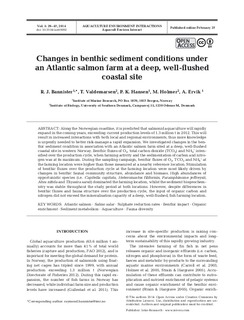| dc.contributor.author | Bannister, Raymond | |
| dc.contributor.author | Valdemarsen, Thomas | |
| dc.contributor.author | Hansen, Pia Kupka | |
| dc.contributor.author | Holmer, Marianne | |
| dc.contributor.author | Ervik, Arne S | |
| dc.date.accessioned | 2015-01-30T09:22:01Z | |
| dc.date.accessioned | 2015-05-04T08:47:09Z | |
| dc.date.available | 2015-01-30T09:22:01Z | |
| dc.date.available | 2015-05-04T08:47:09Z | |
| dc.date.issued | 2014-02-27 | |
| dc.identifier.citation | Bannister RJ, Valdemarsen T, Hansen PK, Holmer M, Ervik A (2014) Changes in benthic sediment conditions under an Atlantic salmon farm at a deep, well-flushed coastal site. Aquacult Environ Interact 5:29-47 | nb_NO |
| dc.identifier.issn | 1869-7534 | |
| dc.identifier.uri | http://hdl.handle.net/11250/282960 | |
| dc.description | - | nb_NO |
| dc.description.abstract | Along the Norwegian coastline, it is predicted that salmonid aquaculture will rapidly expand in the coming years, exceeding current production levels of 1.3 million t in 2012. This will result in increased interactions with both local and regional environments, thus more knowledge is urgently needed to better risk-manage a rapid expansion. We investigated changes in the benthic sediment condition in association with an Atlantic salmon farm sited at a deep, well-flushed coastal site in western Norway. Benthic fluxes of O2, total carbon dioxide (TCO2) and NH4+ intensified over the production cycle, when farming activity and the sedimentation of carbon and nitrogen was at its maximum. During the sampling campaign, benthic fluxes of O2, TCO2 and NH4+ at the farming location were higher than those measured at a nearby reference location. Stimulation of benthic fluxes over the production cycle at the farming location were most likely driven by changes in benthic faunal community structure, abundance and biomass. High abundances of opportunistic species (i.e. Capitella capitata, Heteromastus filiformis, Paramphinome jeffreysii, Abra nitida and Thyasira sarsii) dominated the farming location, whilst the sediment biogeochemistry was stable throughout the study period at both locations. However, despite differences in benthic fluxes and fauna structure over the production cycle, the input of organic carbon and nitrogen did not exceed the mineralisation capacity of a deep, well-flushed, fish farming location. | nb_NO |
| dc.language.iso | eng | nb_NO |
| dc.publisher | Inter-Research | nb_NO |
| dc.rights | Navngivelse-IngenBearbeidelse 3.0 Norge | * |
| dc.rights.uri | http://creativecommons.org/licenses/by-nd/3.0/no/ | * |
| dc.title | Changes in benthic sediment conditions under an atlantic salmon farm at a deep, well-flushed coastal site | nb_NO |
| dc.type | Journal article | nb_NO |
| dc.type | Peer reviewed | nb_NO |
| dc.date.updated | 2015-01-30T09:22:01Z | |
| dc.subject.nsi | VDP::Agriculture and fishery disciplines: 900::Fisheries science: 920::Aquaculture: 922 | nb_NO |
| dc.source.pagenumber | 29-47 | nb_NO |
| dc.source.volume | 5 | nb_NO |
| dc.source.journal | Aquaculture environment interactions | nb_NO |
| dc.source.issue | 1 | nb_NO |
| dc.identifier.doi | 10.3354/aei00092 | |
| dc.identifier.cristin | 1148671 | |

